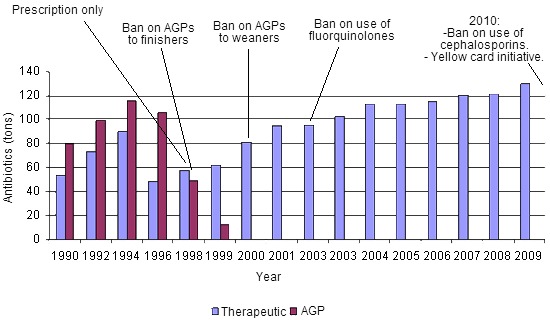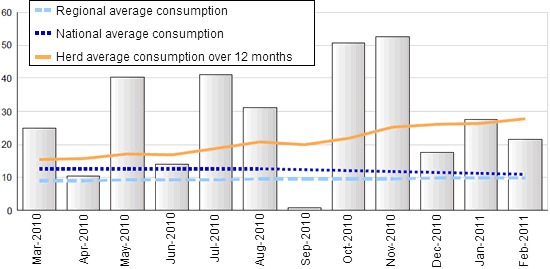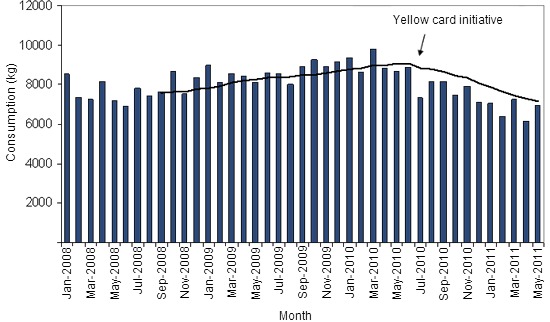In Denmark, a variety of actions have been implemented to regulate antibiotic use in the swine production. It is not possible to compare the consumption of antimicrobials in Denmark with very many other countries, because almost none have a detailed registration on their use of antibiotics for the treatment of livestock. However, among those who collect such data, Denmark has one of the lowest levels of veterinary antibiotic use. The policies taken into action over time are illustrated in Figure 1 and described more detailed in the following article.


Figure 1. Actions taken to regulate antibiotic use in the Danish Swine production. Antibiotic use is for all livestock, of which more than 80 % are used in the pig production.
Strict regulations on veterinary prescriptions
In 1998 veterinary medicine was made prescription only, no longer making it possible for Danish veterinarians to profit on the sales of antibiotics. Regulations are enforced by an increased government control of both veterinarians and producers. Thus, in 2005, Denmark implemented policies requiring biannual audits of veterinarians who serve the swine industry, increasing the veterinarians’ awareness of their prescription patterns.
VETSTAT
In 1998 a monitoring system on the use of antibiotics (VETSTAT) was implemented. By collecting prescription records from both veterinary pharmacies, feed mills, veterinarians and private companies, the system ensures that all use of veterinary antibiotics is registered. This is done at both species and herd level. Veterinarians and producers can draw data for their production sites, and compare them to national or regional average consumption levels (Figure 2). This also makes it possible for the government take actions based on the individual farmer’s use of antibiotics for a given species.

Figure 2. Example of data which can be drawn from VETSTAT by the farmer and practitioner. The figure illustrates the herd’s use of antibiotics per month given in ADD (animal daily doses).
Ban on use of antimicrobial growth promoters
In 1995, the use of the growth promoter Avoparcin was banned followed in 1998 by a ban on the use of growth promoters to finishers. In 2000 a total ban on all growth promotion antibiotics to all age groups of swine was implemented. Bans on growth promotion antibiotics began as voluntary industry efforts that were later implemented as regulation by the government.

As illustrated in Figure 1, the total consumption of antimicrobials decreased significantly due to this action. Following the ban many herds suffered from an increased incidence of diarrhoea among weaners leading to an increased therapeutic consumption of antibiotics. However, Danish swine producers managed to comply with these challenges by implementing multiple changes to their production practices (eg. later weaning, improved diet, increased space pr. piglet, improved flooring).
Restricted use of fluoroquinolones and cephalosporins
Denmark has developed a policy to reduce the use of antibiotics classified as critically important to human medicine by WHO. Thus, in 2002 the veterinary use of fluoroquinolones was restricted to cases where no other antibiotic would be effective. Prescription of fluoroquinolones has to be notified to the government regulatory officials. Also, in 2010, an industrial voluntary ban on the use of cephalosporins was implemented for a 2-year period.
The Yellow Card initiative
In 2010 a new system – the Yellow Card initiative – was developed, targeting the highest consumers of antibiotics in the pig production. Swine farms exceeding the regulatory limit are subject both to injunctions to reduce their use, to increased monitoring by government officials and to various fees. Compared to previous policies, this initiative targets the producers rather than veterinarians.
Each year the Danish Veterinary and Food Administration (DVFA) will issue maximum limits for antibiotic consumption in three age groups of pigs. In 2010, approximately 10% of Danish herds were above the Yellow Card limit. The consumption of antimicrobials in pigs is evaluated as animal daily doses (ADD) per 100 animals seen over the last 9 months (by age group). Current permit limits for a Yellow Card in ADD/100 animal days are 5.2 for sows and piglets, 28 for weaners and 8 for finishers.
In July 2010, farmers with an antimicrobial use close to these limits were warned by the Danish Veterinary and Food Administration, that unless actions were taken to reduce their antimicrobial use, they would receive a Yellow Card in December 2010. The warning resulted in a decrease in the national consumption to pigs of 12.5 % during the last half-year of 2010 compared to the same half-year in 2009. In December 2010 the first Yellow Cards were issued, followed by orders to reduce the antibiotic consumption in the holding below the maximum limits within nine months of the issuance of the injunction. During the 9-month period the authorities may put further restrictions on oral medication usage and make unannounced inspection visits to the holding. The owner of a holding is required to pay a fee for each injunction or prohibition issued, and for all inspection visits. The use of antibiotics in the Danish swine production has continued to decline into 2011. Thus, the consumption in January-June 2011was 25 % lower than for January-June 2010 (Figure 3).

Figure 3. Consumption of antibiotics in the Danish swine production. In July 2010 the Yellow Card initiative was implemented. The black line is the moving 9-month average
The future
The Yellow Card initiative has reduced the antibiotic use in the Danish swine production to a very low level. In a newly published EU-report Denmark has been found to be among the absolutely lowest consumers of veterinary medicine. However, sick animals need to be treated, and therefore the use of antibiotics in the Danish swine production may not be reduced much further.


